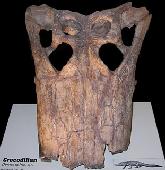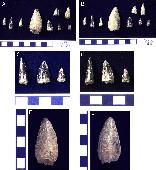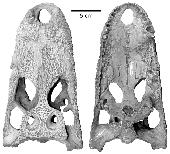|
 See More Images See More Images
(4 total)

Deinosuchus rugosus
© 2005 George E. Phillips, Mississippi Museum of Natural Science

Phytosaurus tooth
© 2005 Utah Geological Survey

Albertochampsa langstoni
© 2008 Royal Tyrrell Museum
|
What are Crocodiles and Relatives? The group Crocodylia consists of modern crocodiles, alligators, and gavials. Crocodilians have a long head with nostrils at the tip of the snout, four legs projecting sideways, heavy scales, a muscular tail, and partially webbed hind feet. Crocodilians are semi-aquatic; they spend much of their time in water, but must lay their eggs on land. Their extinct relatives share many skeletal features with modern crocodilians, but were quite different. Some were small (~ 0.5 meter long), lightly built, and probably preyed on insects and very small reptiles. Others even walked on two legs, or had hind limbs longer than their forelimbs, betraying their bipedal ancestry. The earliest crocodile relatives first appeared in the Late Triassic. First known fossil occurrence: Triassic. Last known fossil occurrence: Quaternary. This group has living relatives. Cool Crocodiles and Relatives links: Search for images of Crocodiles and Relatives on Google |
See Crocodiles and Relatives from the:
|
|




